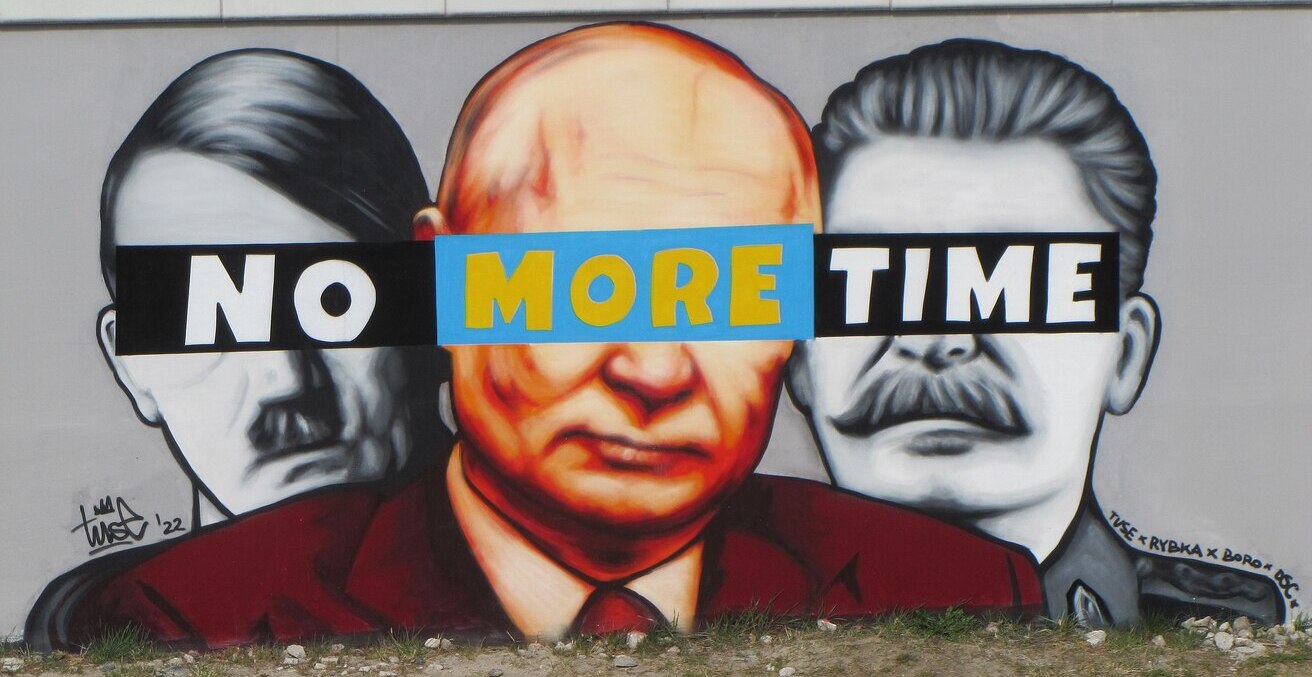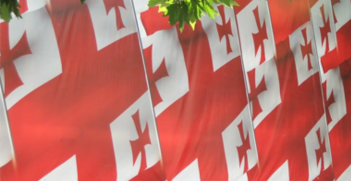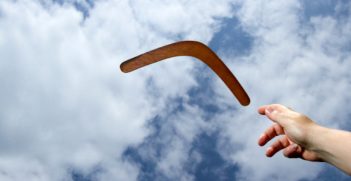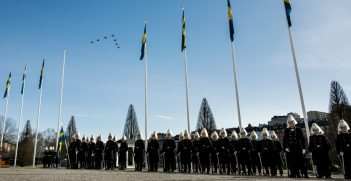Putin Doesn’t Combat Nazism, He Cultivates It

As Russian soldiers marched into Ukraine, the question on everyone’s mind was: “What does Putin hope to achieve with such a massive invasion?” Of the many fanciful distortions manufactured as justification, the pressing need for Ukraine’s “de-Nazification” is the most ludicrous.
In making his case for entering Ukrainian territory with armoured tanks and fighter jets, Russian President Vladimir Putin declared the “special military operation” was undertaken “to protect” victims of the Kyiv regime’s “genocide,” and that Russia “will strive for the demilitarisation and de-Nazification of Ukraine.”
On its face, Putin’s slander is farcical, not least because Ukrainian President Volodymyr Zelenskyy is Jewish, and members of his family were killed during World War II. There is also no proof of mass killings or ethnic purges undertaken by the Ukrainian government. Marking adversaries as Nazis is a typical political tactic in Russia, particularly as leaders benefit from disinformation crusades.
Implying Ukraine is strongly allied with Nazism has been a regular feature of Russian media coverage. The Russian Foreign Ministry posted on Twitter that Ukraine and America voted against a Russian-endorsed UN resolution that would condemn the veneration of Nazism. This neglects to clarify that both countries declined to support Russia’s resolution because they believed it was advancing Moscow’s propaganda objectives, with the U.S. claiming it was a “thinly veiled attempt to legitimise Russian disinformation campaigns.”
Despite a long history of anti-Semitism and pogroms, on the eve of World War II, Ukraine was home to one of the largest Jewish communities in Europe. When German soldiers took control of Kyiv in 1941, they were greeted with “Heil Hitler” banners. Not long after, nearly 34,000 Jews were assembled and trudged to fields outside the city to be slaughtered in what became known as the “Holocaust by Bullets.” Following World War II, because of the policy of state anti-Semitism, all Jewish organisations and institutions were shut down across the Soviet Union from the late 1940’s until its dissolution.
Nowadays, Ukraine’s Jewish community can rejoice in liberties and protections unconceived of by previous generations, including a recent law criminalising anti-Semitic actions. But this law was not introduced without reason — it was designed to tackle a marked increase in public demonstrations of intolerance, specifically Swastika-littered defacement of synagogues and Jewish monuments, and unnerving demonstrations that saluted the Waffen SS. In another unfavourable development, in recent years the country has put up a plethora of monuments venerating Ukrainian nationalists whose legacies are polluted by their undeniable history as Nazi proxies.
The idea that Ukraine is in desperate need of “de-Nazification” is a well-established Russian nationalist narrative. It emanates from World War II, when some Ukrainian partisans aligned with the Nazis against the Soviet Union. Today, Putin has interlaced this history into his fundamentalist visualisation that Ukraine is not a legitimate sovereign country. For Putin, Ukraine is not simply a historically Russian territory incorrectly detached from the motherland. Rather, Ukraine is the successor of a neo-Nazi practice that perpetrated atrocity in Russian in World War II.
Putin’s accusations of genocide also reflect this nationalist narrative. Ukraine includes large ethnic Russian populations, particularly in the east, and many Ukrainians of all ethnicities speak Russian. Putin depicts these people as not simply rightful Russian citizens unjustifiably partitioned from the motherland, but as possible casualties of an ethnic cleansing crusade by the so-called Nazi Ukrainian government.
This is not to deny the far-right threat in Ukraine. Ukraine has a genuine Nazi problem. The most noteworthy, the Azov Movement, is a militia that was instrumental in countering Russia’s incursion in eastern Ukraine in 2014. Initially established as a volunteer group in May 2014, the Azov Battalion developed from the ultra-nationalist Patriot of Ukraine gang and the Social National Assembly. Its inaugural commander was white nationalist Andriy Biletsky ‒ dubbed White Ruler by his supporters ‒ who infamously declared in 2010 that Ukraine’s national purpose was to “lead the white races of the world in a final crusade … against Semite-led Untermenschen [i.e., inferior races].”
Azov gained a reputation with the 2014 Battle of Mariupol, when the Battalion recaptured the eastern Ukrainian city from pro-Russian separatists, establishing its reputation as fierce defenders of Ukraine, willing to fight back against severe odds. Its integration into the Ukrainian National Guard has afforded it a degree of impunity, and made Azov the crème de la crème of its international far-right, neo-Nazi peers. Since, Azov has exploited Ukraine’s predicament to make itself appear more conventionally mainstream by providing public civil defence training gatherings.
Although Azov denies it adheres to Nazi ideology as a whole, its uniforms continue to bear Nazi symbols including SS regalia and the neo-Nazi Wolfsangel symbol, used by Nazi units during World War II. Since 2014, Azov has actively fomented international links, courting support from global far-right, neo-Nazi networks, and outside Ukraine, Azov have seized a principal role in a network of extremist groups that extend from the U.S., Europe, and New Zealand.
Putin has seized upon far-right currents within Ukraine’s militias as evidence of reactionary Nazism while simultaneously cultivating far-right, ultranationalist sentiments. Russia’s most infamous military proxy, the Wagner Group, operates in support of Russian foreign policy objectives, and is trained on installations of the Russian Ministry of Defence. Moscow has utilised their expeditionary forces to wage deniable war and promote the Kremlin’s interests in places like Libya, Syria, Mozambique, and Mali.
The Wagner Group is named after 19th century German composer Richard Wagner, whose music Adolf Hitler adored. In a photo that first emerged on Russian VK accounts and a Telegram group associated with the mercenaries, the group’s leader, Dmitry Utkin, dons neo-Nazi tattoos, including a swastika, Waffen SS lightning bolts, and a Reichsadler Eagle. Wagner mercenaries have reportedly left behind neo-Nazi propaganda in the conflict zones they have meddled in. In Libya, pictures appeared of Wagner combatants, some garbed in German World War II uniforms, purportedly re-enacting scenes from Rommel’s operation against British troops in Libya in 1942.
The Wagner Group been heavily involved in Russia’s protracted war on Ukraine. Its units aided Putin’s illegal annexation of Crimea in 2014 and rebelled alongside pro-Russia separatists in eastern Ukraine. They have also been operating in the present conflict, with dozens of Wagner mercenaries pulled from the Central African Republic to join Russian forces amassing in Ukraine.
There is also the neo-Nazi, white supremacist group the Russian Imperial Movement (RIM), which the U.S. State Department designated a terrorist organisation in 2020. With the Kremlin’s implicit authorisation, the RIM operates paramilitary camps near St. Petersburg, in which neo-Nazis and white supremacists from across Europe are instructed in terrorist tactics.
Putin also utilises neo-Nazi organisations beyond warfare operations. An essential element of the Kremlin’s crusade to manipulate cracks in the West is exploiting transnational white supremacist movements to endorse racially and ethnically inspired violent extremism. Russia serves as a sanctuary and networking hub for far-right extremists, with one of America’s most infamous neo-Nazis finding refuge there. Rinaldo Nazzaro, leader of The Base, an American neo-Nazi, white supremacist paramilitary organisation, lives in Russia and guides the group from St. Petersburg.
Among the virtual ecosystems populated by far-right, white supremacist extremists, Russia’s wanton invasion of Ukraine has been a considerable focus of conversation. Opinion is split — the far-right, white supremacist online environment has never been a monolith. While some ally with Putin, others support Ukraine, or simply hope for carnage and mayhem. Putin’s mission has found a receptive audience among far-right extremists in America, who often look to Putin’s Russia as the last bastion of white, Christian purity. Moscow and its proxies have provided finance and other assistance to these far-right populists across Europe and North America since long before Russia’s invasion. Even before the invasion, as tensions increased between Russia and Ukraine, some far-right groups were already disseminating pro-Russian, anti-Western, anti-Semitic propaganda.
Putin’s weaponisation of neo-Nazis was always a dicey tactic, but it was not illogical. Unlike mainstream nationalists, who often support the concept of free elections, neo-Nazis repudiate democratic institutions and the very idea of egalitarianism. For a dictator disassembling democracy and engineering an authoritarian regime, they were perfect accessories. In Ukraine, Putin is not combating neo-Nazism. The country most in need of “de-Nazification” is Putin’s Russia.
This article was one of the top ten most read articles published in 2022.
Fiona Ballentine is a student at the Australian National University, studying a Bachelor of International Relations and a Bachelor of Arts, with a major in Middle Eastern and Central Asian Studies. Fiona was an intern at the AIIA National Office from February-April 2022.
This article is published under a Creative Commons Licence and may be re-published with attribution.





